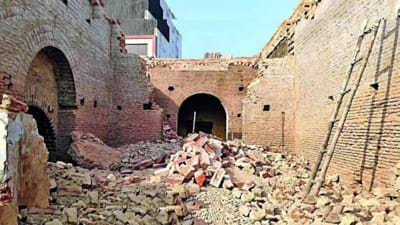Agra: The Mubarak Manzil, a historic 17th-century Mughal-era haveli also known as Aurangzeb’s Haveli, was largely razed to the ground in Agra, sparking outrage among local residents and historians, reports The Times of India. The demolition occurred just three months after the Uttar Pradesh state archaeological department issued a notification to protect the monument. Over 100 tractors of debris were removed from the site, with locals alleging the involvement of a builder in connivance with officials.
Built during Emperor Aurangzeb’s reign, the Mubarak Manzil held immense historical significance. As documented by Austrian historian Ebba Koch in The Complete Taj Mahal and the Riverfront Gardens of Agra, the haveli served as a residence for prominent Mughal figures, including Shah Jahan, Aurangzeb, and Shuja. During British rule, it was repurposed as a customs house and salt office and later came to be known as Tara Niwas by 1902.
In September, the state archaeological department invited objections to declaring the site a protected monument, but none was submitted. Despite officials visiting the site two weeks ago to initiate preservation efforts, demolition commenced shortly afterward, leaving 70% of the structure destroyed.
Local resident Kapil Vajpayee expressed frustration, stating, “I filed multiple complaints with authorities, but no action was taken.”
Residents have accused police and administrative officials of collusion with the builder to facilitate the demolition, even though a police outpost is situated near the site along the Yamuna River.
Agra District Magistrate Aravind Mallappa Bangari acknowledged the incident, saying, “We are aware of the situation. The Archaeological Survey of India and the revenue department have been tasked with probing the matter. A sub-divisional magistrate will visit the site and present a report. Meanwhile, no further alterations will be permitted.”
The Mubarak Manzil’s architectural and historical details were chronicled in an 1871 report by Archibald Campbell Carlyle, highlighting its red sandstone base, arched lower floors, and Mughal-British architectural blend. A marble plaque at the site stated that Aurangzeb built the monument to commemorate his victory at the Battle of Samugarh. Historian Rajkishore Raje noted that Aurangzeb had renamed Dara Shikoh’s palace to mark this triumph.
An 1868 map of Agra placed Mubarak Manzil near the pontoon bridge, now replaced by the iron bridge, indicating its location’s prominence during British rule. The East Indian Railway later used it as a goods depot.
The destruction of Mubarak Manzil has reignited concerns over the preservation of India’s architectural heritage, with historians and locals demanding stringent action against those responsible for the demolition.




